Menu
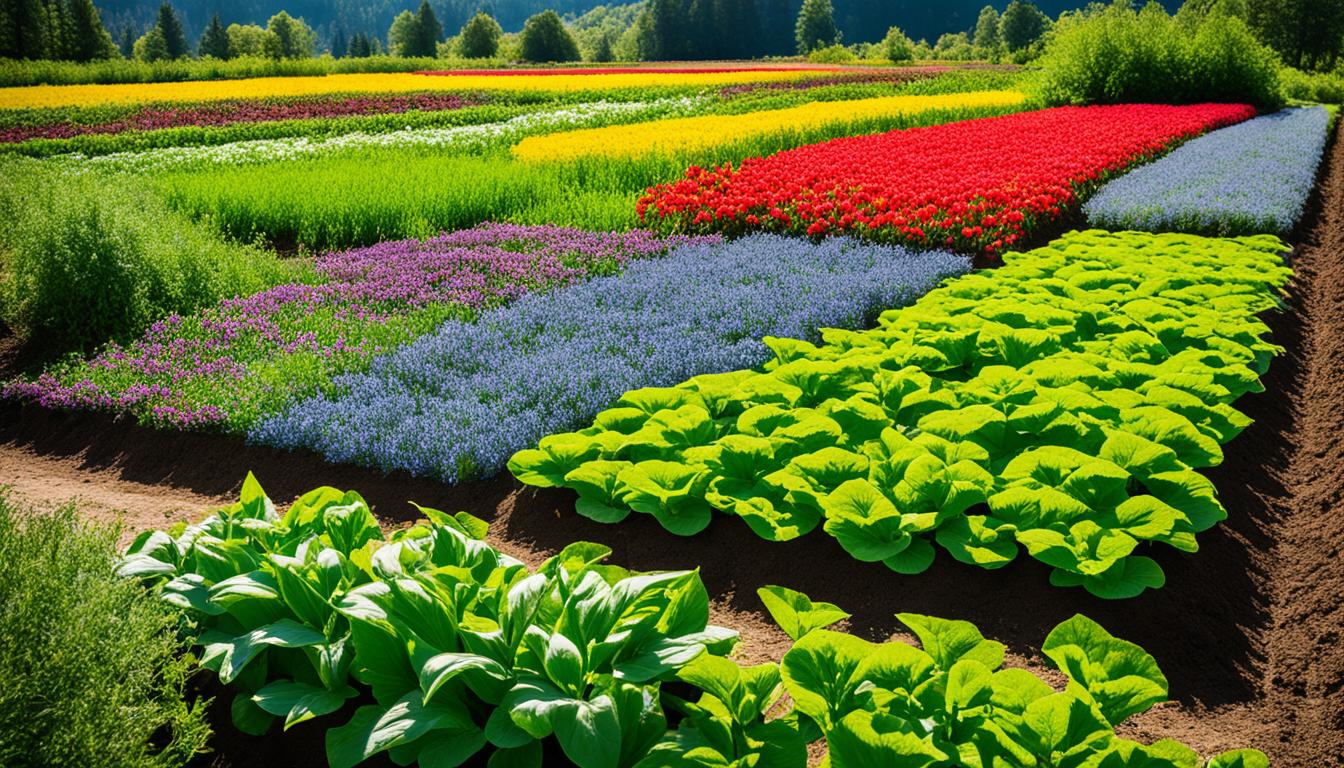
Imagine walking through a rich, lively field. Every plant, insect, and bird is in tune with nature. This beautiful scene is agroecology in action. It combines ecological farming with regenerative agriculture to make a sustainable world. Agroecology has changed how we grow food for the better. It’s good for both us and our planet.
Today, farming often focuses on quick wins, forgetting the future health of our lands. But we’re now facing big issues in looking after the environment. Combining farming with the support of nature is crucial. Agroecology does that. It follows guidelines from the Millennium Ecosystem Assessment. These aim to balance farming needs with keeping our natural systems healthy.
Agroecology’s story starts way back in the 1920s. In the 1930s, Europe began to focus on natural farming. By the 1970s, people saw it as a great, sustainable choice. The FAO created the 10 Elements of Agroecology. These guide us on increasing biodiversity and making farms more productive.
Agroecology is vital today. Most of our calorie intake comes from three main crops. This makes our farming very similar and threatens the rich diversity of nature. Agroecology fights against this by suggesting we grow more varied crops. By doing this, we use our resources better and produce more food. A win-win for us and the environment.
There are great examples of how agroecology supports nature-friendly farming. For instance, ‘fish-friendly’ rice farming protects water life. It shows how farming and biodiversity can go hand in hand. Using natural fertilisers like pulses saves a lot of money and is better for the environment. This and other practices are not only great for the planet but also our wallets.
Agroecology is a new way of looking at sustainable agriculture. It blends environmental and social factors with farming. This effort hopes to change our food system for the better. It will help save resources, boost plant and animal variety, and make sure everybody benefits fairly.
This new method aims to make food and farming fit better with the environment and local customs. It tackles big issues like hunger, using too many resources, and climate change. By working toward these aims, agroecology helps reach the Sustainable Development Goals.
Agroecology doesn’t just push for sustainable farming. It also helps farmers make more money. This plan cuts down on outside help and risky market changes. As a result, it gives farmers a safer and more stable way of life, especially for those in family farms.
Also, agroecological methods are key against climate changes. They defend the food system from bad weather by storing carbon and making farms tougher. These methods also fight climate problems. All together, this makes a strong food system ready for any crisis, like disease outbreaks or sudden market changes.
Agroecology is great for making food more secure. It pushes for healthy and varied meals all year. This helps with making sure food is always there, is easy to get, and people know how to use it.
| Aspect | Benefit |
|---|---|
| Biodiversity | Enhanced pollination, natural pest control, and soil health improvement |
| Economic Resilience | Income stability for farmers, decreased reliance on external inputs |
| Climate Resilience | Carbon sequestration, mitigation and adaptation solutions |
| Food Security | Local and diverse diets, improved availability and access |
Agroecology uses lots of methods like mulching and crop changes. It fits with food sovereignty ideas, supporting farmers and their rights.
More and more, we see how important agroecology is. It’s the way to make our food systems work well for everyone. It makes sure food is available, can be easily got, and well-used.
Biodiversity is vital for farming in a way that is good for the environment, known as sustainable agriculture. It provides many benefits for the health of agricultural lands and forests, ensuring they thrive for years to come.
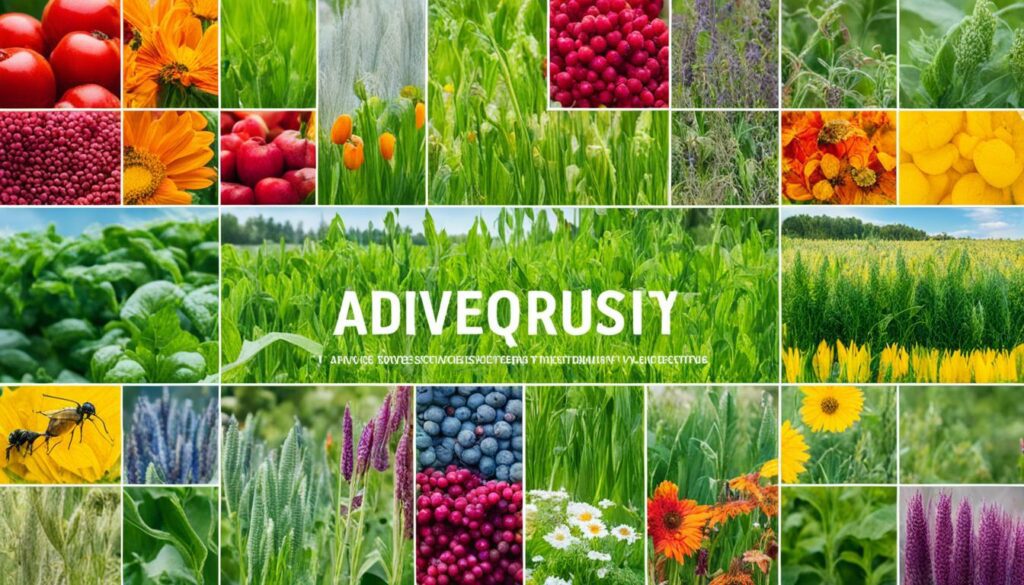
Biodiversity helps with important jobs like pollination, keeping pests under control, and creating healthy soil. For example, large areas of land in the U.S. and around the globe were once filled with different plants and animals, like rainforests. But many of these areas have been turned into farmland. This change underlines why we must work hard to protect biodiversity. Besides, we’ve lost many wetlands because of farming. This loss teaches us we must farm in ways that help our planet thrive.
Biodiversity isn’t just good for nature, though. It also helps the economy by making farming more efficient and reducing the need for harmful chemicals. These chemicals and the waste from farm animals can pollute the environment. But, by wisely using the natural world, we can lower this harm. This approach also offers farmers more ways to make money, helping them and their countries stay strong economically. This is all important because most of the food we eat comes from small, local farms.
In terms of people, biodiversity is key for life, culture, and a variety of foods. More than 1.1 billion people live in places with high biodiversity. This shows how important it is for their way of life and health to keep nature rich in species. Using sustainable farming helps these communities in many ways. It makes them more able to face challenges and improves their diets with different foods.
Agroecology combines many nature-friendly methods to farm sustainably. This includes ways to make sure the land stays healthy and productive for a long time. Three key methods within this are organic farming, permaculture, and agroforestry, and managing pests in a natural way.
Organic farming relies on natural methods, not chemicals. It uses things like compost and green manures to keep the soil healthy. The UN’s Food and Agriculture Organization says this helps stop soil damage and reduces harmful gases in the air.
Permaculture and agroforestry blend plants and trees to make the most of nature’s resources. They act like natural growths, making the land soak up more water and bumping up plant and animal variety. Trees working with crops in agroforestry boost soil and save on resources, making farming both productive and good for the planet.
Instead of spraying lots of chemicals, integrated pest management (IPM) finds clever ways to control pests. It mixes ways to disturb pests’ lives with natural checks like certain plants or bugs that keep the pests at bay. This method keeps crops safe without hurting others and helps soil activities like pollination. By using IPM, farming can support its own needs naturally.
Agroecological practices improve crucial ecosystem services for sustainable farming. These include pollination and controlling pests naturally. They also manage soil health and help prevent climate issues.
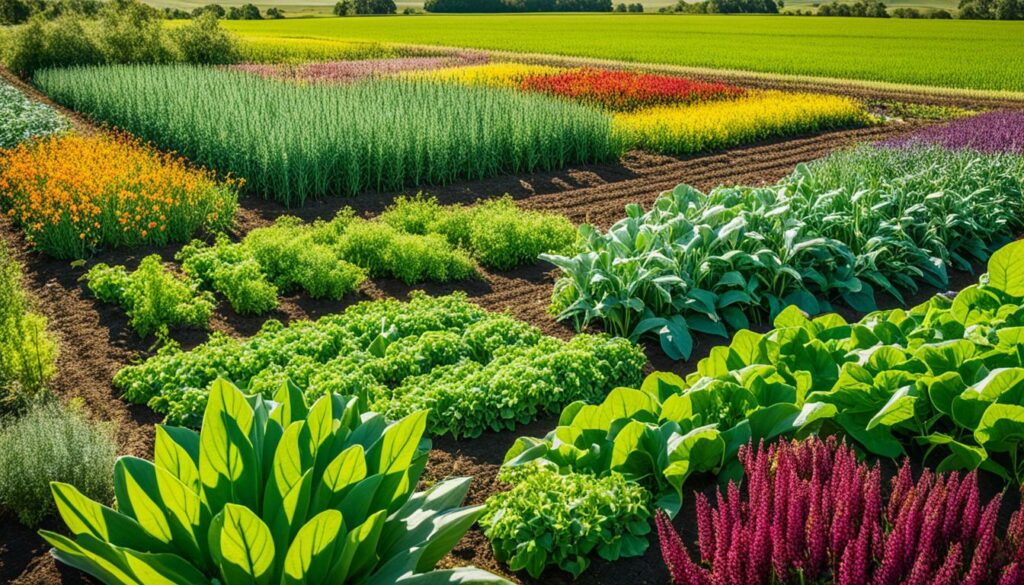
Farms using agroecology help pollination and pest control without heavy use of chemicals. In 2019-2020 in Madrid, Spain’s south-east, 12 agroecological and 12 conventional farms were studied. The agroecological farms applied twice as many helpful methods. These included using different crops, minimal tilling, and natural pesticides. These helped pollinators and managed pests well.
Agroecology focuses on managing soil and water well. A study examined 17 indicators, finding agroecological practices linked to better soil and water. These include using varied crops and natural inputs. They help with soil health and ensure water is used wisely. Agroecology supports eight ecosystem services, while conventional farming only helps with three.
Agroecological approaches play a big part in fighting climate issues. They sequester a lot of carbon, which helps slow climate change. 31 papers confirmed these practices aid climate action. They help farmers cope with changing weather and meet new European farm policies. Agroecology is key in countering global change.
Analysis showed strictly organic agroecological farms, using nine of 13 best practices, performed better than conventional farms. This highlights agroecology’s power in enhancing services important for agriculture’s health. It makes farming systems more durable and sustainable.
Agroecological methods are a key part of caring for our soil. They involve techniques like changing which crops are planted and using covers on the soil. These methods help the soil’s structure and its ability to keep nutrients. It’s crucial because many soils around the world are not in good shape. Around 33% of soils are worn out. This makes it urgent to use these sustainable ways.
In Africa, 40% of soils are not healthy. This makes it harder for people to grow enough food in the countryside. By using agroecology, problems with growing food can be lessened. Methods such as growing different plants together, planting trees among the crops, and changing which crops are planted each season are very helpful. When farmers use these methods, they can have more food that is available all the time. Agroecology is important worldwide, as the FAO supports it.
Making food with industrial methods releases harmful gases. Around 2% of these are from making nitrogen-based food. The process also makes 5-8% of all pollution from the food industry. Nitrogen-based products hurt water and the environment. Also, when there are conflicts, like in Ukraine, making fertilisers becomes harder. This shows the importance of finding better ways to farm.
Agroecological practices offer viable alternatives to the unsustainable industrial model of nitrogen provision.
Agroecology helps the soil by using natural ways. For example, farmers can plant certain types of plants to improve the soil. They also use animal waste to make the soil more fertile. When people learn about farming using these methods, they talk about how to grow many different plants, pick the right seeds, and choose the best times to plant. Doing these things can make their crops better.
Changing from using industrial methods to agroecology can mean more work. But, it gives farmers more control and makes the soil stronger without using many products. Also, agroecology is not just about farming. It’s a way of sharing knowledge and helping each other in the community. People are encouraged to work together to grow food.
It’s very important to study the good and hard parts of using agroecology. For example, many people are interested in a topic about using these methods to look after the soil and water. One article by Emanuela Coller and their team was really popular, being read almost 2,000 times. Another article by Jarmila Čechmánková and their team got a lot of views too, 2,767 times, and was mentioned in other research 11 times.
Indigenous knowledge is key in agroecology, keeping and using old farming ways. Native groups and nature lived together for many years. They’ve kept ways that help take care of the earth and make farming more varied. Today, this knowledge is very important for farming that lasts.
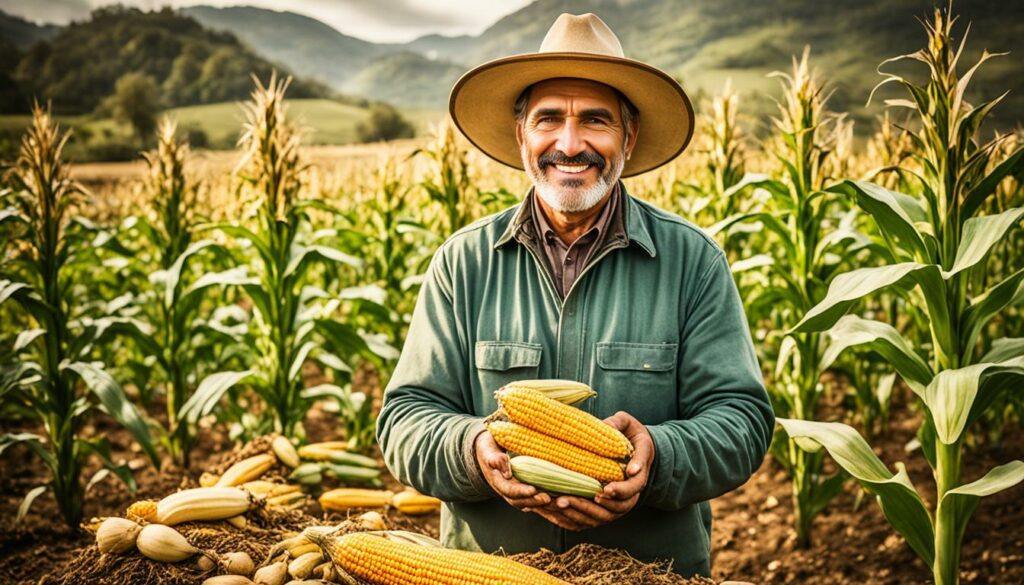
Farmers have long known to work with the land, not against it. For example, in the Mesoamerican area, they mix corn with beans, pumpkin, and chilli. This creates lots of different plants in one area, helping nature. In Africa, farmers mix crops and animals in their fields, which also helps nature a lot. It’s by learning from these traditional ways that we can do farming that’s good for the earth.
There are many stories that show how well these old ways work. In India, Amrita Bhoomi is famous for their Zero Budget Natural Farming. It uses what nature gives, needing very few extra things. This method is great at keeping the land healthy and making sure there’s enough food.
The Global Network of Indigenous Knowledge Resource Centers helps too. They look at the old and new ways native people care for the land. This shows how important keeping traditional knowledge is for saving our earth’s plant and animal life.
| Region | Indigenous Practice | Benefits |
|---|---|---|
| Mesoamerica | Milpa System | Enhances soil health, promotes biodiversity, and supports food security |
| Africa | Diverse Farming Systems | Maintains genetic diversity of crops and livestock, improves resilience |
| India | Zero Budget Natural Farming | Minimises external inputs, enhances biodiversity |
Learning and using old knowledge in modern farming is vital. It helps take care of the land by keeping it varied and healthy. This is good for today and tomorrow’s farming.
Agroecology is like a big hug for biodiversity conservation. It wraps around farming, keeping it more natural. We’re talking about farming that lives and breathes with nature, not against it. This type of farming doesn’t just grow plants; it makes homes for a lot of different creatures. It’s good for the environment and helps farmers too.
When we talk about big, industrial farms, we see a problem. They put nearly 86% of at-risk species in danger of disappearing. Yet, these farms mostly grow just a few things, like wheat, rice, and corn. Imagine, only 12 plants and 5 types of animals are a huge part of what we eat. It’s clear we need to mix things up, to protect nature and ensure there’s enough food for everyone.
Agroforestry mixes trees and shrubs with the usual crops and animals. This mix helps a lot more plants and animals to thrive. It’s a big step towards greater biodiversity in farming. People who’ve been working the land for generations, like peasants and indigenous communities, know a lot about this. They keep the land rich in variety. This is key for fighting off the problems caused by big, industrial farming.
Farmers who go for agroecology help keep our planet diverse and healthy. They make sure their work does more good than harm. A way of farming where nature and people work hand in hand is the best path forward. It’s not just better; it’s what we need to survive in the long run. So, mixing agroecology and biodiversity into our farming is a must for the future of food and our planet.
Agroecology is vital in tackling climate change issues. It is needed because the food system causes a lot of the world’s carbon emissions. Agroecology helps by letting farmers use methods that reduce these emissions. It also makes farming better at facing the challenges of a changing climate.

Practising agroecology helps fight climate change. A report by the IPCC says Europe, using agroecology, could cut emissions by nearly half without harm. These farms are greener and put less stress on the environment. They also do things like planting different crops to keep the soil healthy and trap carbon from the air.
Adjusting to climate change is key for farmers to keep growing food. Agroecology provides ways for them to deal with unpredictable weather. Farmers from Asia to the Americas, using these methods, saw their production grow. These methods also help protect their land from droughts, lessen storm damage, and fight off pests better.
MASIPAG in the Philippines showed that these farmers get back on their feet quicker after extreme weather. This includes typhoons and floods.
| Region | Impact of Agroecology |
|---|---|
| European Union | 47% reduction in emissions |
| Asia, Africa, and Latin America | 25% increase in yields |
| Philippines | Faster recovery post-extreme weather |
Agroecology is a smart approach for farming in a changing climate. It helps farmers by suggesting new crops that survive dry spells and match planting times with shifting weather. For long-lasting food systems, it is important to focus on both coping and lessening the impacts of climate change.
Agroecology helps farmers in many ways, not just with the environment. It changes how they work, making them more efficient and less reliant on things like synthetic chemicals. This switch shows that agroecology is good for their wallets too.
Looking closely at costs and benefits, agroecology shines. It means less money spent on things like fertilisers and pesticides. This is because using natural methods like composting and crop rotation helps reduce these needs. It also makes the land richer, boosting crop growth and income.
Moving to agroecology isn’t just a short-term fix. It’s a long-term strategy for financial health. By making the land healthier and more diverse, farms can weather climate changes better. This means they’ll keep producing well, even when things get tough.
This change can open up new markets, especially for organic goods. Selling in these special markets can mean earning more, making farming a steady business. It offers a more secure way for farmers to earn.
But there’s more. Agroecology does good for the planet too, like taking in carbon and supporting wildlife. These ‘free’ services can also be worth money. They show that by caring for nature, farmers can thrive economically and environmentally.
Good policy frameworks are vital for the move to agroecology. They offer a roadmap for pushing policies that boost nature and sustainable farm methods. Already, many nations have set up their own rules to encourage farmers to look after the land. These rules help protect both wildlife and the environment.
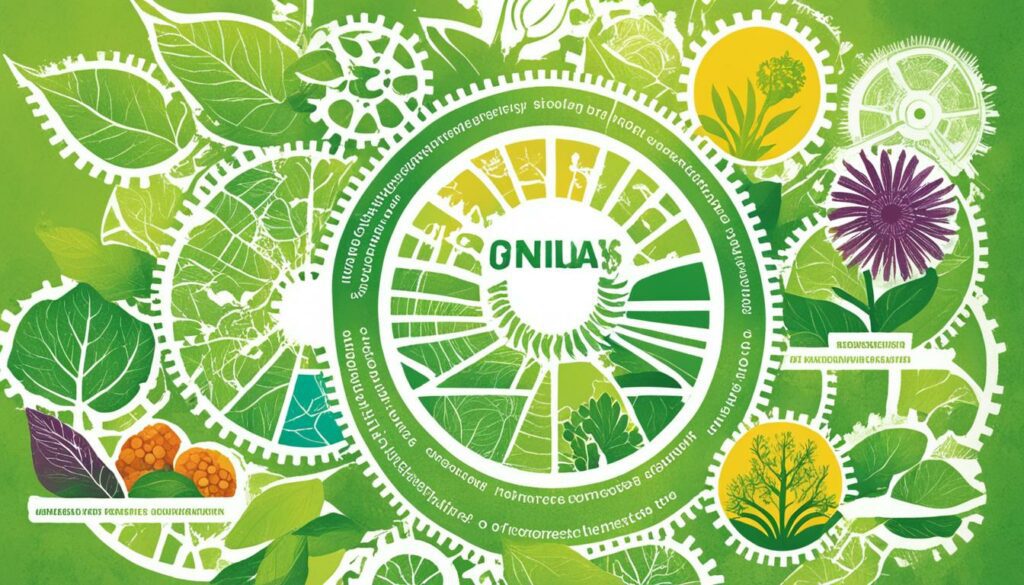
Across the world, policies are key for eco-friendly farming. Groups like the High-Level Panel of Experts help by putting together reports, such as in 2017 about forests. This report showed how important it is to mix farming with caring for nature.
Other events, like the workshops in Córdoba, back up this work globally. They show that many people are dedicated to making farming better for the environment and for us.
In many places, governments are working to join up local and national efforts for the environment. They’re trying things like teaming up with farmers to protect nature better. Countries in Africa, for example, have had success in saving wildlife while farming smarter.
This teamwork helps connect local efforts with bigger plans, making eco-farming work best for everyone.
| Initiative | Level | Impact |
|---|---|---|
| National Legislation | National | Rewards biodiversity-enhancing practices |
| HLPE Forestry Study | Global | Promotes sustainable forestry for food security |
| TAPE Workshops in Córdoba | Local | Evaluates agroecology performance |
| Community-Level Governance | Local | Fosters stakeholder cooperation |
| Agroecosystem Research by Dr. Mabhaudhi | Local | Supports food security and climate adaptation |
Creating policies for eco-farming at all levels is crucial. It shows we’re serious about making farming kinder to the planet. The aim is to keep improving these rules and methods for a better tomorrow.
Moving to agroecology faces big hurdles, although it brings many benefits. One key problem is the current farming policies that support traditional, intensive methods. The big agriculture businesses resist change because they benefit from the way things are. Add in not enough awareness or support for farmers, and you’ve got big obstacles.
Changing the usual way of farming is not easy. The current policies put more emphasis on getting high yields, using a lot of chemicals, and ploughing a lot. Transforming this approach requires a major shift and strong support from leaders.
To make agroecology the norm, we need to change these policies. This means updating laws to stop financing bad farming and making the true cost of farming part of the price. Also, everyone from farmers to policymakers needs to understand and support the agroecology idea.
Teaching is a major part of spreading agroecology. We need to show how farming impacts the planet and people’s health differently, the old versus the new way. Everyone, from farmers to shoppers to leaders, should be involved to make this shift together.
The following table illustrates some key statistics that underscore the urgency of transitioning to agroecological systems:
| Statistic | Detail |
|---|---|
| Hunger | More than 820 million people are suffering from hunger globally. |
| Food Production | Unsustainable patterns exploit natural resources significantly. |
| Greenhouse Gas Emissions | Global agriculture contributes 23% of anthropogenic emissions. |
| Future Food Demands | A 56% increase in crop calories needed by 2050. |
| Land Expansion | Agricultural land might need to expand by 593 million hectares. |
| Climate Mitigation | Agriculture needs to mitigate 11 gigatons of greenhouse gases. |
| Urban Population | 68% of the world’s population projected to live in cities by 2050. |
I firmly believe that by tackling these issues head-on, we can create a more resilient, equitable, and sustainable food system. Efforts must be collaborative, integrating scientific research, technological advancements, and localised initiatives to overcome these inherent challenges of agroecology.
Today, agroecological innovations are key to making farming more eco-friendly. They help us deal with several big challenges. These include losing plant and animal species, wearing out the land, and too much greenhouse gas.
We need to use new tech and science to make these innovations work. The FAO (Food and Agriculture Organisation) lists 10 important parts of agroecology. They talk about mixing different plants and methods to use less land and nurture better soil. This makes farms stronger and able to handle things like climate change.
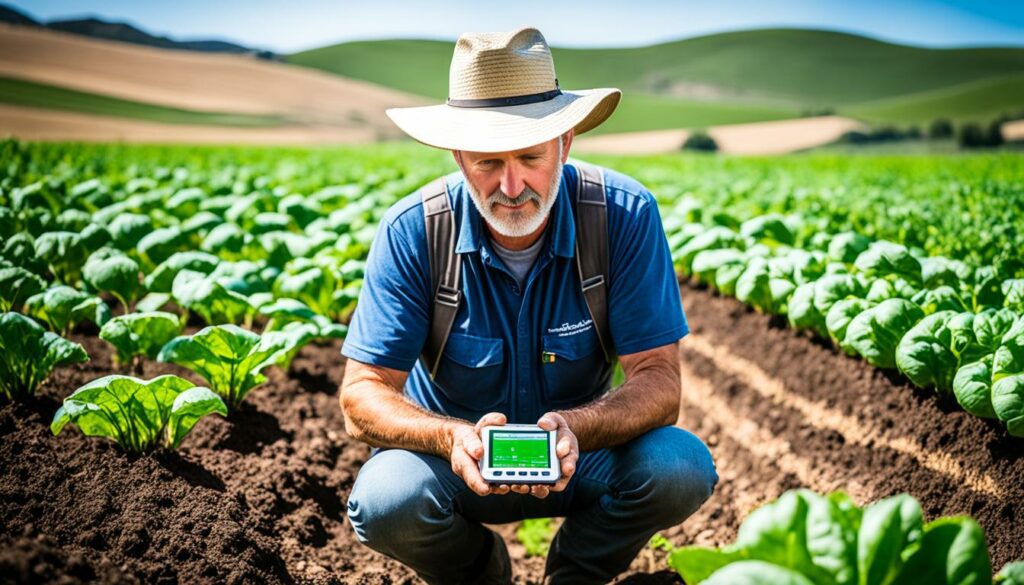
New technology is pushing farming in a better direction. Tools like precision farming are helping us use less while doing more. This is better for the planet. Instead of chemicals, we’re starting to use natural fertilisers. They improve soil and help grow food without harming the earth.
Combining new tech with old farming wisdom is also smart. It’s helping us make farms that can survive even when the weather gets weird. This is a big step in protecting our planet.
Science is really important in making agroecology work. It gives us the facts and ideas we need to farm better. People are working together to come up with good ways to grow food. This means farmers, scientists, and other interested people are all talking and sharing what they know.
This way of working is different from the old ‘boss says what to do’ way. It makes what we learn actually useful for farmers. Figuring out how to mix old farming ways with new ones is a big goal. We want to create farms that are rich in plants, use resources wisely, and make lots of good food.
In the end, using new technology and learning from science is crucial for farming’s future. By working together and using smart ideas, we can make our way of growing food last. This is good news for us and our planet.
Looking at examples from around the world and closer to home shows us how agroecology works. These stories show that different farming methods can make our world greener and more diverse. They also help farmers make more money.
In different parts of the world, farming the earth’s way is making a real impact. Take Brazil, for instance. Farming methods that mix trees with crops are making the land healthier and more alive. In Africa’s dry areas, special farming techniques are turning deserts into fields, making food more available.
Closer to home, unique farming methods are being used, bringing big changes. In places like West and Central Africa, digging wells has changed lives by giving farmers more control over water. Women leading the way in starting small businesses are helping whole communities grow stronger.
There are many documented stories about the success of these methods, thanks to groups like AFSA. They have collected stories from 70 different places, showing how sustainable farming can change lives. Using these stories can help push for better laws and support farmers in taking care of our earth.
Looking ahead, understanding biodiversity trends is key for future agroecology. Taking sustainable steps can help agriculture better withstand challenges. It’s important for agroecologists, policymakers, and workers to come together. They need to ensure our food systems are strong and sustainable.
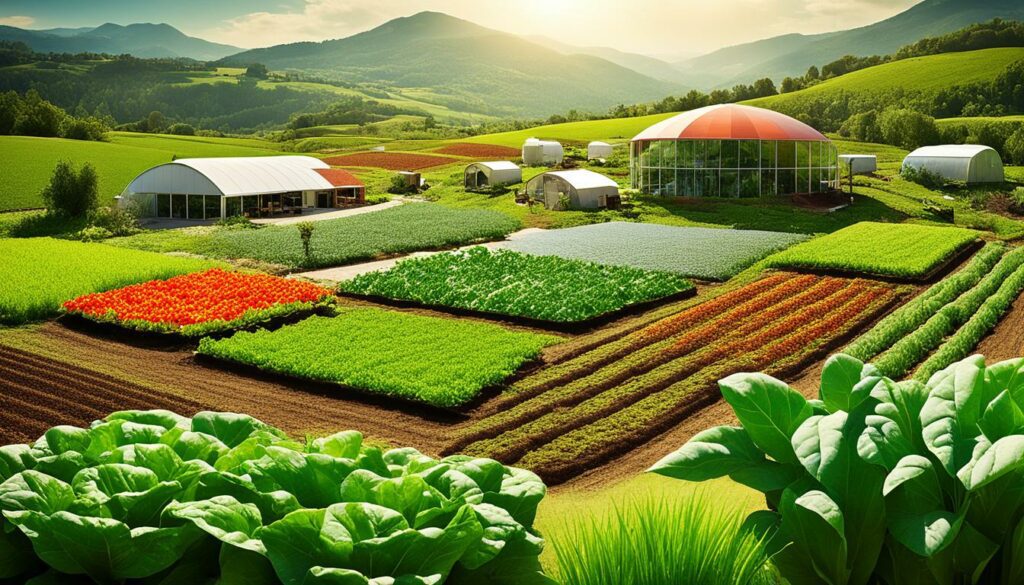
There’s a worrying drop in genetic diversity in farming, affecting our ability to breed crops. It’s crucial to focus on keeping biodiversity. Luckily, we’re seeing more positive links between what we farm and how nature thrives.
Understanding how important biodiversity actions affect everything from single genes to whole ecosystems is vital. It affects the health of all life in farming areas.
| Region | Ecosystem Services Ratio | Biodiversity Impact |
|---|---|---|
| North America | High | Medium |
| Europe | Medium | High |
| Asia | Low | Low |
Many of Earth’s species are facing extinction because of how we currently farm. This is a wake-up call. We need new approaches, like agroecology, to protect our planet’s life forms. Agroecology has already seen success by using fewer chemicals and encouraging natural help.
These challenges urge us to act now. We must combine old wisdom and new science to move forward. Agroecology’s success depends on everyone getting involved. Governments should invest more in farming that respects nature. Community projects can spread successful ideas. Plus, teamwork across all levels—local, national, and global—is key.
In conclusion, the path to a better agroecology future starts with understanding and preserving biodiversity. Joining forces across different sectors is crucial. Together, we can create farming that not only feeds us but also keeps our planet healthy.
Agroecology is leading the way in sustainable farming. It mixes ecology and social aspects in a positive way. The current global farming model is hurting our planet. It puts 28,000 species at risk and changes huge parts of our lands and oceans. We need to switch to agroecology to protect the world before it’s too late.
Around 75% of what we eat comes from just a few plants and animals. This lack of variety is bad for our environment and makes us more at risk. We should farm in a way that celebrates many different kinds of life. This helps our farms be stronger, our nature healthier, and less harmful to the planet.
Everyone from scientists to regular people must come together to change how we farm. Agroecology can help us keep our farms going without damaging our planet. It’s a choice that means we can have plenty of food and a safe world where plants and animals thrive. In Europe, more and more people are talking about giving some farm areas back to nature. This shows a future where we can all live well without harming nature.
Agroecology mixes ecological and social ideas in farming. It saves resources, boosts diversity, and helps keep people and money balanced.
Biodiversity is great for farming in many ways. It helps plants grow by pollinating them. It also fights pests and keeps the soil healthy. This means more food, stronger farms, and happier people.
Agroecology supports eco-friendly farming. It uses methods like organic growing, permaculture, and agroforestry. These ways keep the land rich, diverse, and strong.
Agroecology helps nature help us. It encourages bees to pollinate, bugs to control pests, and the land to stay healthy. This not only fights climate change but also makes farms more productive and stable.
Healthy soil is the base for successful farming. By rotating crops and adding compost, soil stays rich and stops erosion. This keeps farms strong and the food coming.
Indigenous people know about living well with nature. They use local plants and methods that are now key to modern eco-farming.
Farming the agroecology way creates homes for wildlife. It looks after local plants and uses far less harmful chemicals. This helps keep our world in balance.
Agroecology fights climate change by using nature cleverly. It grows a lot of different things and saves energy in the soil. This lessens the harm from a changing climate.
Using eco-friendly ways saves money and boosts profits. Switching to sustainable farming means more cash for farmers. It’s a win for the planet and wallets too.
Laws can push agriculture to be more eco-friendly. They help farmers learn new ways and get to better markets. This supports good eco-farming.
New ways of farming face big hurdles. Old policies, big companies, and not enough knowledge can slow it down. It needs everyone working together to make a real change.
New tech and green fertilisers are making farming better. Merging science and farming shows us how to work with nature. This leads to stronger fields and a healthier planet.
Places that use trees with their crops or organic methods are leading. They prove that nature-friendly farming works. They show how to farm without hurting our world.
With big challenges ahead, green farming will be more important. There’s a push for earth-friendly and smart ways to farm. Traditional wisdom is also valued in the future of farming.